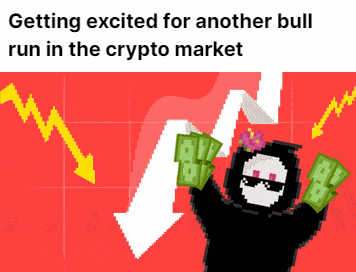When it comes to investing in crypto or the stock market, the terms "bull" and "bear" are crucial. In a bull market, prices rise, the economy thrives, and investors have a positive outlook. Conversely, in a bear market, prices fall, unemployment increases, and investors are desperate to sell. Bear markets usually last around ten months on average, while bull markets occur more frequently and for longer durations.
The origins of these terms are uncertain, but it's helpful to associate them with the hunting behaviour of the animals. Bulls thrust their horns upward, symbolizing rising prices, while bears drive their claws downward, representing falling prices.
However, it's important to note that investing in the bull or bear market is not a straightforward decision. It depends on your investment goals and expectations. Since we're talking about cryptocurrencies and virtual assets, the general rules of the stock market may not apply. Crypto markets are highly volatile, relatively new, and unpredictable, making the journey quite challenging.
Nevertheless, traders and investors in the crypto world still have their strategies and predictions for bull and bear markets, which operate differently compared to traditional stock markets.

Bull Market?
A crypto bull run occurs when prices skyrocket, investors gain confidence, and everyone seems eager to invest. During this period, investors' contagious confidence drives profits higher. In the traditional stock market, a rise of 20% over weeks or months may seem significant, but in crypto, it can surge up to 50% within days!
A bull market is primarily driven by investor sentiment. Unlike the traditional stock market where factors like employment and overall economic health play a role, for crypto, a bull market can be initiated by factors such as the authenticity and social evaluation of a cryptocurrency. A celebrity endorsing a specific crypto or a major finance company integrating a crypto project can trigger a bull run.
In 2017, the crypto market experienced its first breakthrough with Bitcoin prices soaring to $17,700, up from $1,000 at the beginning of the year. Another significant rise occurred in 2021, propelling the market cap from $772 billion to $3 trillion.
However, markets don't stay at their highs forever, and investors must know when to exit. Crypto markets are particularly unpredictable, so having a solid strategy is crucial to fully capitalize on a bull market. General rules for bull markets include buying assets early to maximize ROI, selling some holdings if signs of a bearish market emerge, and setting stop-loss orders with a reasonable margin to protect gains from temporary price spikes.

Bear Market?
A bear market in crypto is the opposite of a bull market. It refers to a period of low confidence and falling prices, where investors become fearful and demand for assets declines.
However, bear markets can also present opportunities to buy undervalued assets once the market stabilizes. Throughout history, significant bear markets have been followed by major bull runs.
Bear markets can be triggered by various factors such as global turmoil, government regulations, or negative sentiment gaining momentum. Accumulation of bad news can lead to a rapid and significant price decrease. After the 2017 bull run, the crypto market experienced a bear market in 2018, and a similar trend occurred after the 2021 bull run. Currently, the crypto market remains in a bearish phase, with prices significantly lower than the highs of 2021.
While investing in a bear market carries risks, there are also opportunities. Strategies employed during bear markets include buying assets at depressed prices ("buy the dip"), implementing a dollar-cost averaging approach, shifting investments to less volatile assets like stablecoins, and selling holdings when signs of a downturn appear in hopes of buying back at lower prices. Caution and consideration of risk tolerance are essential when implementing these strategies.

Invest in FOMO or, Calculate risk in a Bear run?
For explaining the FOMO in a bull market, there are two key ideas that need to be addressed: One: trading space for cryptocurrencies is full of inexperienced traders whose decisions are often driven by emotions; two: the booming value of Bitcoin has led many to look out for the next grand upsurge in crypto. Combining them, you get a humungous amount of traders who are motivated by the fear of missing out on the next big “money-making opportunity”. That’s how the crypto market becomes super volatile and, If you’re not careful enough, you might be on your way to the next bull trap.
As mentioned earlier, the bull runs in the crypto market are often motivated by celebrity tweets and social acceptability. Instead of judging a coin’s inherent value or, usability, people are more drawn to invest by looking at social media trends. So, it is easier than ever for scammers to get in; create hype; take your money, and leave the market. One such case is the meme-coin asset Squid game (SQUID) which experienced a price increase of up to 23 million percent in less than a week. Many assumed that the Squid token will be the next Dogecoin, and bought it when the price was high. Later on, it turned out that SQUID was just a rug-pull scam.
FOMO can happen to anyone, but the possibility of stepping on it is more for investors looking into a bull market only with the intention of making quick profits. While investing in the popular crypto is not always a bad idea, you might want to step back and assess whether your decision is solely driven by its “popularity”. Having actual knowledge of the coin might save you from the loss when the assets suffer major correction.
When an asset goes through a periodic spike, the FOMO in the community goes high. As a result, many are tempted to buy that asset. After which, comes the correction period, declining the value of those assets. This declination has no specific time limit. Depending on the asset’s usability and value, it can be a permanent declination with no trace of recovery. That is how FOMO investing during a bull run can drain you out!

On the other hand, Bear market investments lie on the opposite end of the spectrum. By definition, a bear market indicates falling prices. The prices stoop low, followed by the confidence of the investors. But here’s the catch: when the prices hit the bottom, the only way they can go is upward. For investors, this could mean buying assets at a price much lower than their value. Through proper research and strategy implication, a bear market can be a favourable play for you. Dip buying and dollar-cost averaging can help you mindfully invest in assets that will lead to profitable gains.
But what if you buy an asset that does not recover? Here’s where the general psychology kicks in: contrary to a bull market, everything is so tipsy in a bear market that you are more likely to assess decisions with extra caution, and the chances of making a biased move due to ongoing trends are nearly zero.
Conclusion
With that being said, the risks still exist. But a proper plan minimizes those to a huge extent. When compared to FOMO investing in a bull market, the risks involved are calculated and can be accounted for in the bear market. To say the least, you will not be impulsed into a seemingly lucrative crypto project that will eventually turn out to be a scam with no trace of recovery.